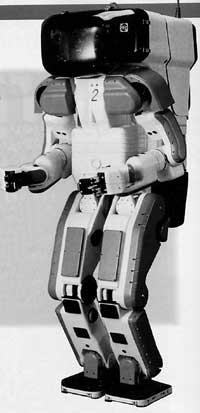Dawn of autonomous robots
2000/09/05 Roa Zubia, Guillermo - Elhuyar Zientzia
It is true that when talking about robots comes to mind a metal box praying with human appearance. And, of course, that doesn't exist. Robots are designed for maximum mechanical work. Therefore, they are usually small structures formed by steel or plastic arms and legs. They usually have small motors instead of positronic muscles.
Great research is done on robots. They are almost indispensable in space exploration. To collect a sample from any planet, for example, you need a robot that can move at a distance. The presence of obstacles in the soil or its peculiar mechanical characteristics are frequent.
Knowing the physical conditions in advance is not easy to design a suitable robot. In the last issue of the journal Nature, however, the great progress made in this direction has been made known. An article describing the last step of a line of research has been published. Hod Lipson and Jordan B. The authors are pollack.
Starting from a concrete problem
Many small changes can be made in complex robots. It is difficult to know which combination will give the best result. Therefore, it provides the initial conditions (robot components, start-up place, etc.) and the computer calculates and tests the possibilities. The best robots thus invented are mounted with rapid prototyping technology.
This robot manufacturing procedure has been developed by engineers Hod Lipson and Jordan Pollack at a university in Massachusetts. The robots are plastic and only measure about twenty centimeters. The mechanical characteristics measured in computer tests have also been tested on real prototypes. Theoretical calculations have been very precise. Now, what can such a robot do?
On the one hand, collect the stones or sand from Mars and take them to a container. Even closer they can snow and, in general, overcome obstacles with difficult conditions. These characteristics can be used in salvage. Closer you can still do several jobs inside home. But all this was also known before this week's article. What then is progress?
In science, as in most cases, progress is not the result, but the procedure. The computer calculates how the robot should be and other machines end the prototype. However, the only work that human beings should do is describe the problem to the computer. It's not a simple job, but from there you can go to sleep without worrying about anything. That is the advance. In space exploration, in addition, initial conditions are not known until the probe landing. This procedure should not be done from the robot and spend a huge amount of money before knowing the real obstacle.
Based on evolution
Another important point is the work done by the computer. This work is based on the evolution of theoretical prototypes. They use the algorithm to calculate new generations of robots. The mechanical characteristics of each prototype are analyzed and those of low quality are discarded. It is an idea similar to natural selection. Thus, hundreds of generations are calculated from day to day. If we did this "by hand", inventing, manufacturing and testing the prototype, it would take years and years before obtaining a selfish result. However, computers use virtual reality to save that heavy work.
However, this technique still presents serious obstacles. It is not all solved. Prototypes with conventional technology cannot be made. Rapid prototyping technology solidifies plastic materials in the required locations. It is therefore difficult to do so with traditional methods.
On the other hand, the evolution algorithm used by the computer starts with zero and performs random mutations. It does not follow a solid initial structure or strategy. Each can assess the autonomy status of robots. It is in its beginnings, no doubt. But you can't talk about movie robots.

Gai honi buruzko eduki gehiago
Elhuyarrek garatutako teknologia





